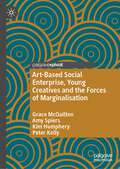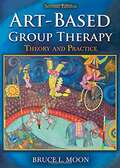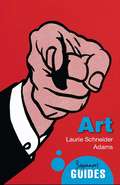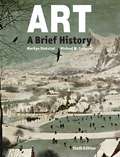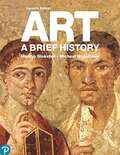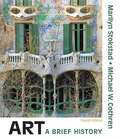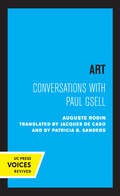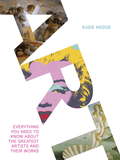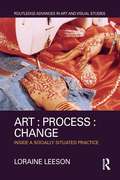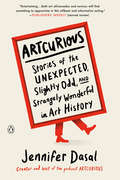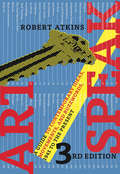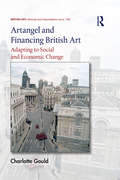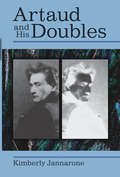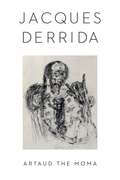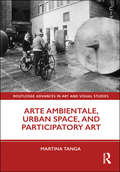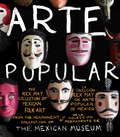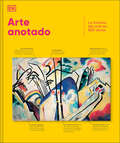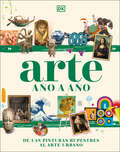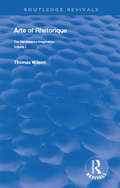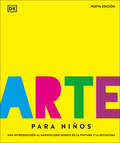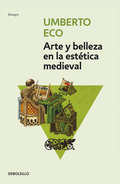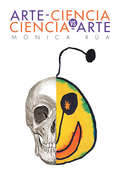- Table View
- List View
Art-Based Social Enterprise, Young Creatives and the Forces of Marginalisation
by Peter Kelly Kim Humphery Grace McQuilten Amy SpiersThis book analyses the challenges and opportunities faced by art-based social enterprises (ASEs) engaging young creatives in education and training and supporting their pathways to the creative industries. In doing so, it addresses the complex intersecting issues of marginality and entrepreneurship, particularly in relation to young creatives from socially, economically and culturally diverse backgrounds. Drawing on extensive fieldwork and interviews with twelve key organisations, and three in-depth case studies in Australia, the book offers a detailed analysis of using enterprise to engage with the structural challenges of marginality. The book explores the local and global contexts through which art-based social enterprises (ASEs) operate and within which they attempt – often successfully – to improve access to education and work for emerging creatives. It also attends to the findings generated through engaging with the lived experiences of the staff and young creatives involved in our ASE case studies, in order to understand both the challenges and impacts of the ASE model on young people’s education, training, and employment pathways. The book focuses on three broad themes; precarious youth and digital futures, material practice and sustainable economies, and cultural citizenship in the urban fringe. In exploring these themes, the book contributes to debates about the limits, possibilities and challenges that attach to, and emerge from, an ASE model and highlights the ways in which these models can contribute to young people’s well-being, engagement, education and training, and work pathways. More broadly, it examines the possibilities of art as a means of social and cultural engagement. In the context of the precarious future of the creative industries, this book emphasise the ways in which young artists are building alternative economic and cultural models that support both individual pathways and collective change. This book will move the field forward with a critical lens that engages closely with experience and the lived realities of juggling multiple priorities of social, economic and artistic goals.
Art-based Group Therapy: Theory And Practice
by Bruce L. MoonIn this second edition Moon provides essential principles regarding art-based therapy groups. The book is intended for art therapy students and practitioners, offering philosophic and practical information related to the use of art in a host of group therapy contexts.
Art-based Group Therapy: Theory and Practice
by Bruce L. MoonPerhaps more than ever before, today's art therapists are being encouraged to apply their knowledge base to the development of strategies for community building, and art-based approaches to preventing and treating emotional problems. In many settings, individual counseling or psychotherapy is no longer financially feasible. Art-based group therapy allows art therapists to work with many more clients than would be possible in individual sessions. Moreover, art-based group process also has unique qualities that can often serve as the treatment of choice for many clients.
Art: A Beginner's Guide (Beginner's Guides)
by Laurie Schneider AdamsArt has existed for as long as humankind, but defining it is notoriously difficult. In this whirlwind tour spanning from prehistory up to the present day and beyond, Laurie Schneider Adams explores how art and our views on it have evolved. Delving into fascinating issues such as why some artworks can be so controversial, why a forgery can never be as "good" as the original, and what the future of art may hold, this beautifully crafted introduction provides a deft overview of Western artistic tradition. Also providing a helpful guide to understanding art terminology and to reading artworks for meaning, Art: A Beginner's Guide is an essential tool for every budding art critic. Laurie Schneider Adams is Professor of Art at John Jay College, City University of New York. She is the author of A History of Western Art and Looking at Art, and is Editor-in-Chief of the journal Source: Notes in the History of Art.
Art: A Brief History
by Marilyn Stokstad Michael W. CothrenFor Art History Survey courses The most student-friendly, contextual, and inclusive art history survey text on the market Now in its sixth edition, Art: A Brief History continues to balance formal analysis with contextual art history in order to engage a diverse student audience. Authors Marilyn Stokstad and Michael Cothren, both scholars as well as teachers, share a common vision that survey courses should be filled with as much enjoyment as learning, and that they should foster an enthusiastic, as well as an educated, public for the visual arts. By treating the visual arts as one component of a vibrant cultural landscape (which also includes politics, religion, economics, and more), Art: A Brief History helps students recognize and appreciate the central role that art and architecture have played in human history.
Art: A Brief History
by Marilyn Stokstad Michael CothrenFor courses in Art History Survey A welcoming, inclusive, engaging, and global approach to art Revel™ Art: A Brief Historybrings the history of art to life for a new generation of students. The concise version of Stokstad and Cothren’s Art History is global in scope, inclusive in its coverage, and warm and welcoming in tone. The guiding vision of the text is that the teaching of art history survey courses should be filled with equal delight, enjoyment, and serious learning, while fostering an enthusiastic and educated public for the visual arts. The 7th Edition has been revised to reflect new discoveries, recent research, and fresh interpretive perspectives, as well as to address the changing needs of both students and educators.
Art: A Brief History (4th edition)
by Marilyn Stokstad Michael W. CothrenThis book features excellent scholarship, takes a global approach with an emphasis on the Western tradition in art. It reflects new interests and issues, expanding the topic to include women and minorities, and showing media and techniques other than painting, sculpture, and architecture. This book serves as an introduction to the history of art and a ready reference for people working in the arts, including museum docents, and art gallery employees, owners, and managers.
Art: Conversations with Paul Gsell (Quantum Books)
by Auguste RodinThis title is part of UC Press's Voices Revived program, which commemorates University of California Press’s mission to seek out and cultivate the brightest minds and give them voice, reach, and impact. Drawing on a backlist dating to 1893, Voices Revived makes high-quality, peer-reviewed scholarship accessible once again using print-on-demand technology. This title was originally published in 1984.
Art: Everything You Need to Know About the Greatest Artists and Their Works
by Susie HodgeArt introduces readers to 100 of the world's most important artists and their paintings, from the 13th century to the modern era. Works by artists including Caravaggio, Vermeer, van Gogh and Warhol are reproduced in superb high quality, arranged chronologically and set in their historical context by Susie Hodge's concise and readable narrative. Including explanations of key periods in art history - from the Early Renaissance to Dutch Realism, and from Rococo to Pop Art - a guide to the world's best art galleries and a helpful glossary of key terms, this is the perfect book for any art lover.
Art: Everything You Need to Know About the Greatest Artists and Their Works
by Susie HodgeArt introduces readers to 100 of the world's most important artists and their paintings, from the 13th century to the modern era. Works by artists including Caravaggio, Vermeer, van Gogh and Warhol are reproduced in superb high quality, arranged chronologically and set in their historical context by Susie Hodge's concise and readable narrative. Including explanations of key periods in art history - from the Early Renaissance to Dutch Realism, and from Rococo to Pop Art - a guide to the world's best art galleries and a helpful glossary of key terms, this is the perfect book for any art lover.
Art: Inside a Socially Situated Practice (Routledge Advances in Art and Visual Studies)
by Loraine LeesonThis book brings a practitioner’s insight to bear on socially situated art practice through a first-hand glimpse into the development, organisation and delivery of art projects with social agendas. Issues examined include the artist’s role in building creative frameworks, the relationship of collaboration to participation, management of collective input, and wider repercussions of the ways that projects are instigated, negotiated and funded. The book contributes to ongoing debates on ethics/aesthetics for art initiatives where process, product and social relations are integral to the mix, and addresses issues of practical functionality in relation to social outcome.
ArtCurious: Stories of the Unexpected, Slightly Odd, and Strangely Wonderful in Art History
by Jennifer DasalA wildly entertaining and surprisingly educational dive into art history as you've never seen it before, from the host of the beloved ArtCurious podcastWe're all familiar with the works of Claude Monet, thanks in no small part to the ubiquitous reproductions of his water lilies on umbrellas, handbags, scarves, and dorm-room posters. But did you also know that Monet and his cohort were trailblazing rebels whose works were originally deemed unbelievably ugly and vulgar? And while you probably know the tale of Vincent van Gogh's suicide, you may not be aware that there's pretty compelling evidence that the artist didn't die by his own hand but was accidentally killed--or even murdered. Or how about the fact that one of Andy Warhol's most enduring legacies involves Caroline Kennedy's moldy birthday cake and a collection of toenail clippings?ArtCurious is a colorful look at the world of art history, revealing some of the strangest, funniest, and most fascinating stories behind the world's great artists and masterpieces. Through these and other incredible, weird, and wonderful tales, ArtCurious presents an engaging look at why art history is, and continues to be, a riveting and relevant world to explore.
ArtSpeak: A Guide To Contemporary Ideas, Movements, And Buzzwords, 1945 To The Present (G - Reference,information And Interdisciplinary Subjects Ser.)
by Robert AtkinsThe leading lexicon of contemporary art returns in an expanded, full-color third edition and is now available for the first time as an ebook.An indispensable guide for art-world neophytes and seasoned professionals alike, the best-selling ArtSpeak returns in a revised and expanded third edition, illustrated in full color. Nearly 150 alphabetical entries-30 of them new to this edition-explain the who, what, where, and when of postwar and contemporary art. These concise mini-essays on the key terms of the art world are written with wit and common sense by veteran critic Robert Atkins. More than eighty images, most in color, illustrate key works of the art movements discussed, making ArtSpeak a visual reference, as well as a textual one. A timeline traces world and art-world events from 1945 to the present day, and a single-page ArtChart provides a handy overview of the major art movements in that period.
Artangel and Financing British Art: Adapting to Social and Economic Change (British Art: Histories and Interpretations since 1700)
by Charlotte GouldThe Artangel Trust has been credited with providing artists with all the money and logistics they need to create one-off dream projects. An independent art commissioning agency based in London, it has operated since 1985 and is responsible for producing some of the most striking ephemeral and site-specific artworks of the last decades, from Rachel Whiteread’s House to Jeremy Deller’s The Battle of Orgreave. Artangel’s existence spans three decades, which now form a coherent whole in terms of both art historical and political periodisation. It was launched as a reaction to the cuts in funding for the visual arts introduced by the Thatcher government in 1979 and has since adapted in a distinctive way to changing cultural policies. Its mixed economic model, the recourse to public, private and corporate funds, is the result of the more general hybridisation of funding encouraged by successive governments since the 1980s and offers a contemporary case study on broader questions concerning the specificities of British art patronage. This book aims to demonstrate that the singular way its directors have responded to the vagaries of public funding and harnessed new national attitudes to philanthropy has created a sustainable independent model, but also that it has been reflected more formally, in their approach to site. The locational art produced by the agency has indeed mirrored new distinctions between public and private spaces, it has reflected the social and economic changes the country has gone through and accompanied the new cultural geographies shaping London and the United Kingdom. Looking into whether their funding model might have had a formal incidence on the art they helped produce and on its relation to notions of publicness and privacy, the study of Artangel gives a fresh insight into new trends in British site-specific art.
Artaud and His Doubles
by Kimberly JannaroneArtaud and His Doublesis a radical re-thinking of one of the most influential theater figures of the twentieth century. Placing Artaud's writing within the specific context of European political, theatrical, and intellectual history, the book reveals Artaud's affinities with a disturbing array of anti-intellectual and reactionary writers and artists whose ranks swelled catastrophically between the wars in Western Europe. Kimberly Jannarone shows that Artaud's work reveals two sets of doubles: one, a body of peculiarly persistent received interpretations from the American experimental theater and French post-structuralist readings of the 1960s; and, two, a darker set of doubles—those of Artaud's contemporaries who, in the tumultuous, alienated, and pessimistic atmosphere enveloping much of Europe after World War I, denounced the degradation of civilization, yearned for cosmic purification, and called for an ecstatic loss of the self. Artaud and His Doubleswill generate provocative new discussions about Artaud and fundamentally challenge the way we look at his work and ideas.
Artaud the Moma (Columbia Themes in Philosophy, Social Criticism, and the Arts)
by Jacques DerridaIn 1996 Jacques Derrida gave a lecture at the Museum of Modern Art in New York on the occasion of Antonin Artaud: Works on Paper, one of the first major international exhibitions to present the avant-garde dramatist and poet's paintings and drawings. Derrida's original title, "Artaud the Moma," is a characteristic play on words. It alludes to Artaud's calling himself Mômo, Marseilles slang for "fool," upon his return to Paris in 1946 after nine years in various asylums, while playing off of the museum's nickname, MoMA. But the title was not deemed "presentable or decent," in Derrida's words, by the very institution that chose to exhibit Artaud's work. Instead, the lecture was advertised as "Jacques Derrida . . . will present a lecture about Artaud's drawings."For Derrida, what was at stake was what it meant for the museum to exhibit Artaud's drawings and for him to lecture on Artaud in that institutional context. Thinking over the performative force of Artaud's work and the relation between writing and drawing, Derrida addresses the multiplicity of Artaud's identities to confront the modernist museum's valorizing of originality. He channels Artaud's specter, speech, and struggle against representation to attempt to hold the museum accountable for trying to confine Artaud within its categories. Artaud the Moma, as lecture and text, reveals the challenge that Artaud posed to Derrida—and to art and its institutional history. A powerful interjection into the museum halls, this work is a crucial moment in Derrida's thought and an insightful, unsparing reading of a challenging writer and artist.
Arte Ambientale, Urban Space, and Participatory Art (Routledge Advances in Art and Visual Studies)
by Martina TangaWorking in 1970s Italy, a group of artists—namely Ugo La Pietra, Maurizio Nannucci, Francesco Somaini, Mauro Staccioli, Franco Summa, and Franco Vaccari—sought new spaces to create and exhibit art. Looking beyond the gallery, they generated sculptural, conceptual, and participatory interventions, called Arte Ambientale (Environmental Art), situated in the city streets. Their experiments emerged at a time of cultural crisis, when fierce domestic terrorism aggravated an already fragile political situation. To confront the malaise, these artists embraced a position of artistic autonomy and social critique, democratically connecting the city's inhabitants through direct art practices.
Arte Popular: The Rex May Collection of Mexican Folk Art
by The Mexican MuseumArte Popular features 100 pieces from Rex May's extensive collection of exquisite hand-crafted objects from all over Mexico.Coming from the reputable Mexican Museum, this volume demonstrates the dramatic power of folk art.This bilingual volume provides a veritable treasure trove of discoveries for the curious reader. • Features bold and atmospheric photographs• Includes scholarly essays that delve into the collection's origins and significance• A visual treat for lovers of Mexican art, craft, and visual cultureThe Rex May Collection–bequeathed to the Mexican Museum by the legendary 39-Mile-Drive sign designer–demonstrates the dramatic power of folk art.This book is a companion to the opening of the Mexican Museum building in downtown San Francisco's Yerba Buena museum neighborhood. • Perfect for museum goers and fans of Mexican arts and crafts• The Mexican Museum has been a San Francisco cultural destination and educational resource for 37 years, and became the only San Francisco affiliate of the Smithsonian Institution in 2012.• You'll love this book if you love books like Mexican Details by Joe P. Carr and Karen Witynski, Crafts of Mexico by Margarita de Orellana and Alberto Ruy Sanchez, and Masks of Mexico: Tigers, Devils, and the Dance of Life by Barbara Mauldin.
Arte Programmata: Freedom, Control, and the Computer in 1960s Italy
by Lindsay CaplanTracing the evolution of the Italian avant-garde&’s pioneering experiments with art and technology and their subversion of freedom and control In postwar Italy, a group of visionary artists used emergent computer technologies as both tools of artistic production and a means to reconceptualize the dynamic interrelation between individual freedom and collectivity. Working contrary to assumptions that the rigid, structural nature of programming limits subjectivity, this book traces the multifaceted practices of these groundbreaking artists and their conviction that technology could provide the conditions for a liberated social life.Situating their developments within the context of the Cold War and the ensuing crisis among the Italian left, Arte Programmata describes how Italy&’s distinctive political climate fueled the group&’s engagement with computers, cybernetics, and information theory. Creating a broad range of immersive environments, kinetic sculptures, domestic home goods, and other multimedia art and design works, artists such as Bruno Munari, Enzo Mari, and others looked to the conceptual frameworks provided by this new technology to envision a way out of the ideological impasses of the age.Showcasing the ingenuity of Italy&’s earliest computer-based art, this study highlights its distinguishing characteristics while also exploring concurrent developments across the globe. Centered on the relationships between art, technology, and politics, Arte Programmata considers an important antecedent to the digital age.
Arte anotado (Art, Annotated): La historia del arte en 500 obras
by DKTranspórtate a una galería de arte en este recorrido por más de 3000 años de pintura, escultura y grabados. Lleno de información e imágenes, y organizado cronológicamente, este libro de arte presenta una exquisita recopilación de las obras más importantes de todo el mundo, acompañadas de anotaciones y análisis detallados que te ayudarán a comprender el simbolismo de cada de una de ellas y su contexto histórico.¡Aprende cómo Miguel Ángel pintó desnudos, qué es el cubismo o de dónde vino la abstracción y disfruta observando las imágenes de tus pinturas y esculturas favoritas!Pasa sus páginas y prepárate para descubrir: Obras realizadas por más 450 artistas de todo el mundo y de culturas diferentes, pertenecientes a diferentes períodos y movimientos artísticos.La composición, el color, la técnica y el simbolismo de cada una de ellas.Imágenes grandes que reproducen cada detalle de manera brillante, acompañadas de explicaciones y comentarios que te ayudarán a entenderlas mejor.Una sección con todos los autores de las obras que aparecen a lo largo del libroContempla frescos del antiguo Egipto, descifra las pistas visuales de La última cena de Leonardo da Vinci y descubre qué inspiró a Louise Bourgeois y Banksy en este libro de consulta visual. Una fuente de inspiración inigualable para todo amante del arte que busca seguir aprendiendo sobre la historia del arte universal.---------------------------------------------------A stunning art gallery in a book, art, annotated spans more than 3,000 years of paintings, sculptures, and prints. Combining reproductions of each work of art with precise annotations and visual analysis, it is an expertly curated selection of the finest art ever created.Immerse yourself in this book and learn all about art - how Michelangelo painted nudes, what cubism is, and where abstraction came from. Discover ancient Egyptian frescoes, read the visual clues to Leonardo da Vinci's Last Supper, and find out what inspired Louise Bourgeois and Banksy. In this art book, you will find:Art from all over the world exploring key elements such as composition, color, technique, and symbolism.Profiles the work of more than 450 artists from across the world and many different cultures, covering every period and major art movement.Art set in its historical context, which makes art, annotated a complete overview of art history.A 32-page directory of biographies of all the artists featured at the back of the book. Packed with information and full of inspiration, art, annotated brings the finest paintings and sculptures right into your home. It is the ultimate history of art and visual sourcebook for all art lovers.
Arte año a año (Art Year by Year): De las pinturas rupestres al arte urbano
by DKEste excelente libro está recorrido de principio a fin por una sola línea cronológica, creando una fantástica galería de arte a través de la historia, desde las pinturas rupestres hasta el arte callejero, y mucho más.Se exploran y explican movimientos artísticos como el Renacimiento, el Impresionismo, el Surrealismo y el Pop Art. También hay biografías de las figuras clave tras algunas de las obras de arte más conocidas del mundo, desde Rembrandt hasta Rodin, Botticelli y Banksy. Con cada historia trazada en una línea temporal, las páginas de este libro ofrecen una fotografía instantánea de cada época y revelan las influencias y conexiones detrás de las obras de arte y movimientos artísticos que han reflejado nuestro mundo.Con más de 1,000 imágenes de pinturas, dibujos, fotografías y esculturas, 'Arte año a año' es la mejor guía visual de la historia del arte, siglo a siglo, año tras año.This terriffic book has a single timeline running through it – a glorious gallery of art through history, from prehistoric cave paintings to street art, and everything in between.Art movements such as the Renaissance, Impressionism, Surrealism, and Pop Art are explored and explained. There are biographies, too, of key figures behind some of the world&’s best-known artworks, from Rembrandt to Rodin, Botticelli to Banksy. With every story plotted on a timeline, the pages give a snapshot of each era, and reveal the influences and connections behind the works of art and artistic movements that have reflected our world.With more than 1,000 images of paintings, drawings, photographs, and sculptures, 'Arte año a año' is the ultimate visual guide to the history of art, century by century, year by year.
Arte of Rhethorique (Routledge Revivals)
by Thomas WilsonOriginally published in 1982, this book includes The Arte of Rhetorique by Thomoas Wilson, alongisde a critical analysis by Thomoas J. Derrick. It includes chapters on biographical context, a critical introduction, and historical collation.
Arte para niños (Children's Book of Art)
by DKDescubre el poder del arte e inspírate con culturas de todo el mundo con 'Arte para Niños'. Aprenderás sobre las vidas y los fascinantes logros de grandes artistas y escultores, desde Leonardo da Vinci y Fernando Bolero hasta Picasso.El libro está repleto de datos y fotos que destacan estilos artísticos de todo el mundo, desde las primeras pinturas rupestres hasta el arte renacentista y el surrealismo, pasando por los soldados de terracota de China y la escultura africana.Además, incluye actividades y proyectos divertidos para que los más pequeños creen sus propias obras de arte: el regalo ideal para futuros pintores y escultores.Discover the power of art and be inspired by cultures from all over the world with 'Arte para Niños'. You'll learn about the fascinating lives and achievements of great artists and sculptors, from Leonardo da Vinci to Bolero and Picasso. The book is packed with facts and photos highlighting artistic styles from around the world, from the very earliest cave paintings to Renaissance art and surrealism, via China's terra-cotta army, and African sculpture.Plus, there are fun activities and projects so you can create your own works of art-the perfect gift for budding painters and sculptors.
Arte y belleza en la estética medieval
by Umberto EcoUna compilación de las teorías estéticas elaboradas por la cultura del Medioevo, desde el siglo VI hasta el XV de nuestra era. El concepto de «estética» nace en Europa en el siglo XVII y, por lo tanto, muchas historias de la estética tomaron en escasa consideración las teorías de la belleza y del arte elaboradas antes de estas fechas. Ahora bien, desde hace muchos años la actitud de los historiadores ha cambiado y la Edad Media se ha valorizado como una época rica en especulaciones fascinantes sobre la belleza, el placer estético, el gusto, la belleza natural y la artificial, las relaciones entre el arte y las demás actividades humanas. En este compendio de las teorías estéticas elaboradas por la cultura del Medioevo, desde el siglo VI hasta el XV de nuestra era, Eco reconoce, de forma accesible para el lector no especializado, las etapas de un debate que presenta aspectos dramáticos y apasionantes, y nos permite entender mejor la mentalidad y el gusto artístico del hombre medieval. Reseña:«Un estudio delicioso... Tremendamente lúcido y fácil de leer, el ensayo de Eco está cargado de excelencia y de la energía de un hombre enamorado de la materia.»Boston Globe
Arte-ciencia vs ciencia-arte
by Susana Mónica Rúa López<P>El protagonismo del arte, la cultura, el derecho y la comunicación integrados a una ciencia impregnada de humanismo son los pilares fundamentales para acompañar al individuo en el proceso de crecimiento, en su educación, en su reeducación en los procesos terapéuticos de rehabilitación y reinserción. <P>El arte excede, transgrede, llega a una instancia de uno mismo donde se encuentran los misterios, el dolor y la liberación del pesar, la rabia, la desesperación, el anhelo y la esperanza. Negar lo biológico no es prudente pues es un componente del ser humano por naturaleza. La modalidad de enfermar está ligada a la cultura, el derecho y la comunicación. El modelo social con menor desarrollo espiritual en relación a otros momentos históricos, se presenta impregnado de materialismo y tecnológicamente avanzado. Dicta en consecuencia modelos que bloquean y esto hace que a veces enferme. <P>No se trata de renegar contra la modernidad sino integrarla para colaborar con el individuo; brindarle elementos a éste de cómo utilizarla en beneficio de un crecimiento sano. Una ciencia despojada de humanismo y que reniega de su historia no acompaña al individuo en su crecimiento sino colabora a que enferma. <P>El arte integrado a un equipo interdisciplinario se presenta con un conjunto de elementos para colaborar a ofrecer un servicio que coadyuve a su felicidad.
